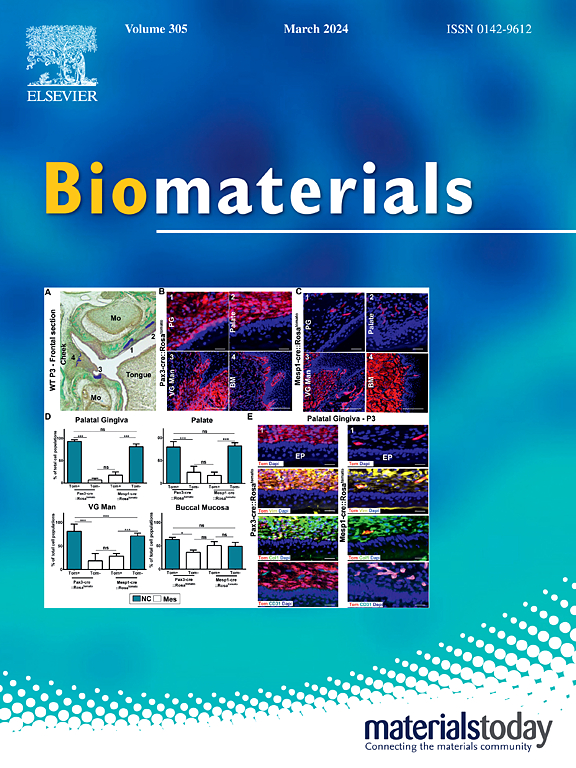Conjugation of peptides to a dendrimer surface to promote the proliferation and differentiation of human pluripotent stem cells into cardiomyocytes and retinal pigment epithelium
IF 12.9
1区 医学
Q1 ENGINEERING, BIOMEDICAL
引用次数: 0
Abstract
Human pluripotent stem cells (hPSCs), of which differentiated cells can be used in cell therapy and regenerative medicine, cannot proliferate on traditional polystyrene surfaces. Instead, hPSCs are typically cultivated on surfaces coated with Matrigel, which includes xeno-containing substances. Hence, it is advisable to employ biomaterials conjugated to synthetic peptides to promote hPSCs proliferation. hPSCs have been successfully cultured for more than 10 passages on surfaces conjugated to specific peptides derived from extracellular matrix (ECM) proteins. However, the concentration of peptide solution needed for conjugation is high (typically >1000 μg/mL). To overcome this limitation, novel cell culture biomaterials using a polyamidoamine (PAMAM) dendrimer-based peptide-conjugated surface, which allow high peptide surface density locally, were developed in this study. We successfully cultured hPSCs on a PAMAM dendrimer surface conjugated to a specific peptide designed on the basis of the laminin β4 chain; this surface was generated with a low concentration of peptide (50 μg/mL) that was on the same order of magnitude as that used to coat the surface with ECM solution (5–10 μg/mL). After long-term (10 passages) cultivation on the peptide-conjugated dendrimer surface, hPSCs exhibited pluripotency and the potential to differentiate into cells from all three germ layers, as well as cardiomyocytes for the treatment of myocardial infarction and retinal pigment epithelial cells for the treatment of retinal pigmentosa disease. 3D peptide conjugation (immobilization) at high density on the surface via the PAMAM dendrimer supports maintenance of hPSC pluripotency via low concentrations of peptides during long-term cultivation.
树突表面结合多肽促进人多能干细胞向心肌细胞和视网膜色素上皮的增殖和分化
人类多能干细胞(hPSCs)是一种可用于细胞治疗和再生医学的分化细胞,它不能在传统的聚苯乙烯表面增殖。相反,高效能干细胞通常是在涂有基质的表面上培养的,其中包括含xeno物质。因此,采用与合成肽结合的生物材料促进人乳头状细胞增殖是可取的。人类造血干细胞已经成功地在细胞外基质(ECM)蛋白结合的特定肽表面上培养了超过10代。然而,偶联所需的肽溶液浓度很高(通常为1000 μg/mL)。为了克服这一限制,本研究开发了一种新型细胞培养生物材料,该材料使用聚酰胺胺(PAMAM)树突基肽偶联表面,可以在局部实现高肽表面密度。我们成功地在PAMAM树突状表面培养了hPSCs,该树突状表面结合了基于层粘连蛋白β4链设计的特定肽;该表面是用低浓度的肽(50 μg/mL)形成的,与用ECM溶液涂覆表面(5-10 μg/mL)相同的数量级。在肽偶联树突表面长期(10代)培养后,hPSCs表现出多能性和分化为所有三种胚层细胞的潜力,以及治疗心肌梗死的心肌细胞和治疗视网膜色素变性疾病的视网膜色素上皮细胞。通过PAMAM树状大分子在表面高密度的三维肽偶联(固定)支持在长期培养过程中通过低浓度的肽维持hPSC的多能性。
本文章由计算机程序翻译,如有差异,请以英文原文为准。
求助全文
约1分钟内获得全文
求助全文
来源期刊

Biomaterials
工程技术-材料科学:生物材料
CiteScore
26.00
自引率
2.90%
发文量
565
审稿时长
46 days
期刊介绍:
Biomaterials is an international journal covering the science and clinical application of biomaterials. A biomaterial is now defined as a substance that has been engineered to take a form which, alone or as part of a complex system, is used to direct, by control of interactions with components of living systems, the course of any therapeutic or diagnostic procedure. It is the aim of the journal to provide a peer-reviewed forum for the publication of original papers and authoritative review and opinion papers dealing with the most important issues facing the use of biomaterials in clinical practice. The scope of the journal covers the wide range of physical, biological and chemical sciences that underpin the design of biomaterials and the clinical disciplines in which they are used. These sciences include polymer synthesis and characterization, drug and gene vector design, the biology of the host response, immunology and toxicology and self assembly at the nanoscale. Clinical applications include the therapies of medical technology and regenerative medicine in all clinical disciplines, and diagnostic systems that reply on innovative contrast and sensing agents. The journal is relevant to areas such as cancer diagnosis and therapy, implantable devices, drug delivery systems, gene vectors, bionanotechnology and tissue engineering.
 求助内容:
求助内容: 应助结果提醒方式:
应助结果提醒方式:


